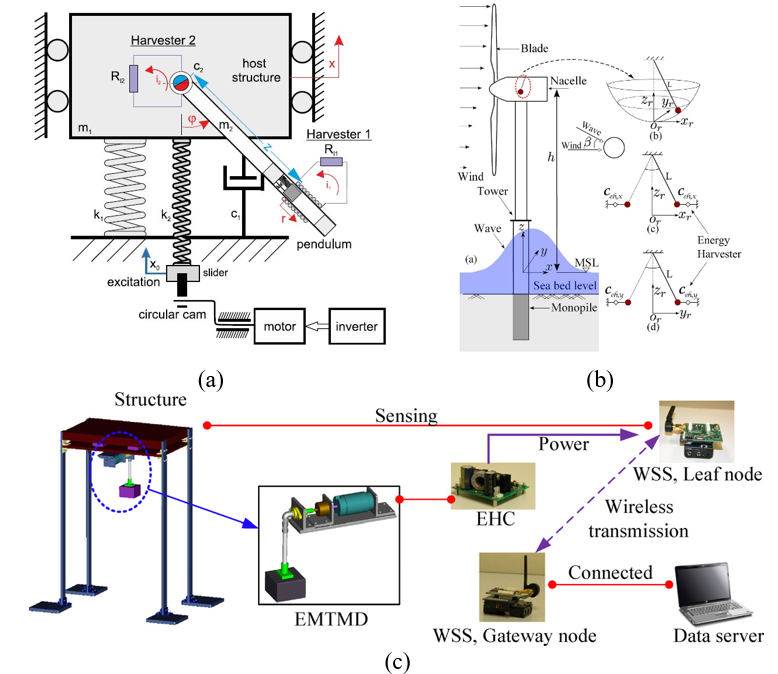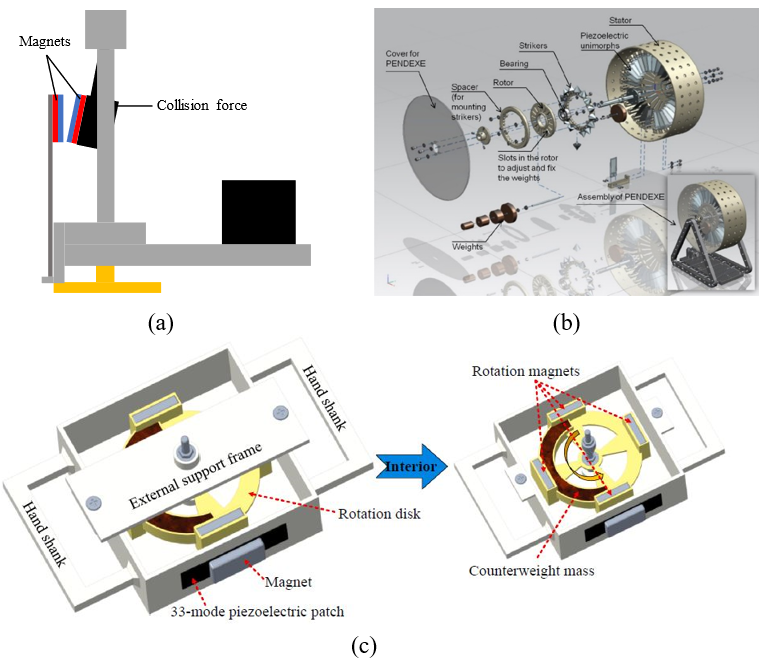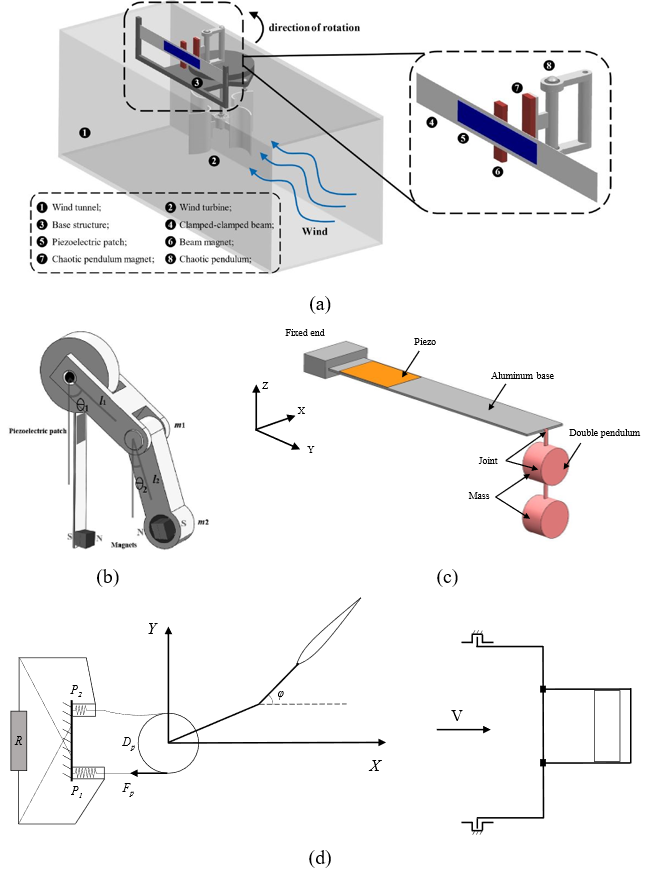Energy harvesting systems based on the pendulum structures have been widely used in the low-frequency environmental energy collection applications in recent years. In this study, the research progresses of the pendulum energy harvesting structures are described in detail and summarized. The energy harvesting structures are classified according to pendulum types and different energy conversion mechanisms. The improved techniques and design schemes adopted in the relevant research are also summarized.
- vibration energy harvesting
- single pendulum
- double pendulum
- Introduction
As shown in Figure 1, pendulum structures can be used in a variety of applications in energy harvesting technologies. Compared with other structures, pendulum have richer dynamic characteristics and better motion bearing capacity. But at present, there are few literatures to analyze the energy harvesting technologies based on pendulum structure. Therefore, in order to make up for the deficiency of this part, this study summarizes the energy harvesting systems based on the pendulum structures in detail, including the basic pendulum structures, energy conversion mechanisms and applications.

Figure 1. Classification of pendulum energy harvesting technologies.
- Pendulum energy harvesters
At present, many scholars have studied the characteristics of simple pendulum structure. Jia et al. [1] adopted a pendulum structure for electromagnetic energy harvesting to reduce the resonant amplitude threshold. In addition, some studies have shown that the pendulum structures show excellent effects on the low frequency and broadband energy harvesting performance [2]. Dai et al. [3] established a theoretical model of a single pendulum energy converter, and calculated the ratio of the half-peak bandwidth to the center frequency. Correlation analysis shows that the pendulum structure successfully improves the bandwidth of energy harvesting.
Kecik et al. [4] studied a coupled vibratory pendulum system. Figure 2a shows the main structure of the system, including a tuned mass damper and two independent energy harvesting devices. The influence of magnetic levitation and rotating harvester on vibration absorption is analyzed. In addition, the pendulum structure energy harvesting system can also be applied to shock absorption, such as the offshore wind turbines [5]. In order to effectively mitigate the effects of vibration, OWT is equipped with various shock absorbing structures. Jahangiri et al. [6] used electromagnetic generators instead of linear dampers to capture energy. The main structure of the device is a spherical pendulum that absorbs vibrations and collects energy in the x and y directions. The schematic diagram is shown in Figure 2b. The simulation results show that the axial and radial displacement of the nacelle is reduced by about 70% and 77%, respectively. Shen et al. [7] proposed a self-powered vibration reduction monitoring system based on the pendulum structure. The main structure is shown in Figure 2c. The structure can produce an average power of 312.4mW.
 Figure 2. (a) Electromagnetic energy harvester with a pendulum-tuned mass damper [4]. Reprinted with permission from Ref. [4]. Copyright 2020, Elsevier. (b) OWTs with a pendulum-tuned mass damper [6]. Adapted with permission from Ref. [6]. Copyright 2019, Elsevier. (c) Self-powered vibration reduction and monitoring system [7]. Reprinted with permission from Ref. [7]. Copyright 2012, Elsevier.
Figure 2. (a) Electromagnetic energy harvester with a pendulum-tuned mass damper [4]. Reprinted with permission from Ref. [4]. Copyright 2020, Elsevier. (b) OWTs with a pendulum-tuned mass damper [6]. Adapted with permission from Ref. [6]. Copyright 2019, Elsevier. (c) Self-powered vibration reduction and monitoring system [7]. Reprinted with permission from Ref. [7]. Copyright 2012, Elsevier.
Piezoelectric energy harvesting is widely used for vibration energy conversion [8, 9]. Piezoelectric energy harvesting technology has many advantages, such as higher energy density, higher voltage and lower mechanical damping [10]. Daniel et al. [11] proposed a piezoelectric energy harvesting system that can be applied to the sea bottom. In another study, Zhang et al. [12] designed a new multidirectional pendulum energy harvester based on homopolar repulsion. As shown in Figure 3a, the proposed system is applied to the conversion of inertial kinetic energy of the unmanned passenger car. In addition, Shukla et al. [13] developed a pendulum energy collector (Figure 3b) that can be mounted on the human body to capture energy from waist movement. Bao et al. [14] designed a handheld human motion energy collector, as shown in Figure 3c. Wu et al. [2] proposed a piezoelectric spring pendulum oscillator based on a clamp-type structure. The spring pendulum is directly integrated with the piezoelectric element to improve the energy collection performance.
 Figure 3. (a) Multi-directional pendulum kinetic energy harvester [12]. (b) Human waistline movement energy harvester [13]. Reprinted with permission from Ref. [13]. Copyright 2014, Elsevier. (c) Hand-held human motion energy harvester [14].
Figure 3. (a) Multi-directional pendulum kinetic energy harvester [12]. (b) Human waistline movement energy harvester [13]. Reprinted with permission from Ref. [13]. Copyright 2014, Elsevier. (c) Hand-held human motion energy harvester [14].
Chen et al. [15] proposed a rotational wind energy harvester based on magnetic double-pendulum system. As shown in Figure 4a. Izadgoshasb et al. [16] applied the double pendulum system to human movement energy collection, as shown in Figure 4b. Sun et al. [17] used the internal resonance between the double pendulum and the cantilever beam to expand the bandwidth of the piezoelectric energy collector (Figure 4c). Selyutskiy et al. [18] designed a fluid-induced vibration energy collector based on a double pneumatic pendulum.
 Figure 4. (a) Rotational wind energy harvester based on magnetic double pendulum [15]. (b) Double-pendulum energy harvester applied in human motion energy conversion [16]. Reprinted with permission from Ref. [16]. Copyright 2019, Elsevier. (c) Piezoelectric cantilever beam coupled with double pendulum [17]. (d) Flow-induced vibration energy harvester based on double aerodynamic pendulum [18].
Figure 4. (a) Rotational wind energy harvester based on magnetic double pendulum [15]. (b) Double-pendulum energy harvester applied in human motion energy conversion [16]. Reprinted with permission from Ref. [16]. Copyright 2019, Elsevier. (c) Piezoelectric cantilever beam coupled with double pendulum [17]. (d) Flow-induced vibration energy harvester based on double aerodynamic pendulum [18].
- Conclusion
This study reviews the researches on the theoretical analyses of the single and double pendulums and their applications in energy harvesting. The different energy-conversion mechanisms, design schemes, and optimal structures of pendulum-like energy harvesters have been summarized. Based on the existing research, single-pendulum energy harvesters are predominantly applied in ultra-low-frequency environments and multi-directional energy harvesting. The working conditions of pendulum energy harvesters are <10 Hz, which mainly include ocean wave and human motion energy. Furthermore, single-pendulum systems can be combined with the other functions, such as mechanical motion rectifiers and structural damping. In addition, energy harvesting based on the double pendulums has attracted much research attention.
References
- Jia, Y.; Yan, J.Z.; Soga, K.; Seshia, A.A. Parametric resonance for vibration energy harvesting with design techniques to passively reduce the initiation threshold amplitude. Smart Mater. Struct. 2014, 23(6), 065011, https://doi.org/10.1088/0964-1726/23/6/065011.
- Wu, Y.P.; Qiu, J.H.; Zhou, S.P.; Ji, H.L.; Chen, Y.; Li, S. A piezoelectric spring pendulum oscillator used for multi-directional and ultra-low frequency vibration energy harvesting. Energy 2018, 231, 600-14, https://doi.org/10.1016/j.apenergy.2018.09.082.
- Dai, X. An vibration energy harvester with broadband and frequency-doubling characteristics based on rotary pendulums. Actuator A-Phys. 2016, 241, 161-8, https://doi.org/10.1016/j.sna.2016.02.004.
- Kecik, K.; Mitura, A. Energy recovery from a pendulum tuned mass damper with two independent harvesting sources. J. Mech. Sci. 2020, 174, 105568, https://doi.org/10.1016/j.ijmecsci.2020.105568.
- Jahani, K.; Langlois, R.G.; Afagh, F.F. Structural dynamics of offshore Wind Turbines: A review. Ocean Eng. 2022, 251, 111136, https://doi.org/10.1016/j.oceaneng.2022.111136.
- Jahangiri, V.; Sun, C. Integrated bi-directional vibration control and energy harvesting of monopile offshore wind turbines. Ocean Eng. 2019, 178, 260-9, https://doi.org/10.1016/j.oceaneng.2019.02.015.
- Shen, W.A.; Zhu, S.Y.; Xu, Y.L. An experimental study on self-powered vibration control and monitoring system using electromagnetic TMD and wireless sensors. Actuator A-Phys. 2012, 180, 166-76, https://doi.org/10.1016/j.sna.2012.04.011.
- Bao, B.; Wang, Q. Bladeless rotational piezoelectric energy harvester for hydroelectric applications of ultra-low and wide-range flow rates. Energy Conv. Manag. 2021, 227, 113619, https://doi.org/10.1016/j.enconman.2020.113619.
- Prajwal, K.T.; Manickavasagam, K.; Suresh, R. A review on vibration energy harvesting technologies: analysis and technologies. Phys. J.-Spec. Top. 2022, 231(8), 1359-71, https://doi.org/10.1140/epjs/s11734-022-00490-0.
- Covaci, C.; Gontean, A. Piezoelectric Energy Harvesting Solutions: A Review. Sensors 2020, 20(12), 3512, https://doi.org/10.3390/s20123512.
- Toma, D.M.; del Rio, J.; Carbonell-Ventura, M.; Masalles, J.M. Underwater energy harvesting system based on plucked-driven piezoelectrics. In Proceedings of the Oceans 2015 Genova, Ctr Congressi Genova, Genova, ITALY, 18-21 May 2015, https://doi.org/10.1109/OCEANS-Genova.2015.7271599.
- Zhang, T.S.; Tang, M.F.; Li, H.; Li, J.B.; Zou, Y.Q.; Pan, Y.J.; Zhang, Z.T. A Multidirectional Pendulum Kinetic Energy Harvester Based on Homopolar Repulsion for Low-Power Sensors in New Energy Driverless Buses. J. Precis Eng Manuf-Green Technol. 2022, 9(2), 603-18, https://doi.org/10.1007/s40684-021-00344-5.
- Shukla, R.; Bell, A.J. PENDEXE: A novel energy harvesting concept for low frequency human waistline. Actuator A-Phys. 2015, 222, 39-47, https://doi.org/10.1016/j.sna.2014.11.016.
- Bao, B.; Wang, Q.; Wu, N.; Zhou, S. Hand-held piezoelectric energy harvesting structure: Design, dynamic analysis, and experimental validation. Measurement 2021, 174, 109011, https://doi.org/10.1016/j.measurement.2021.109011.
- Chen, J.T.; Bao, B.; Liu, J.L.; Wu, Y.F.; Wang, Q. Piezoelectric energy harvester featuring a magnetic chaotic pendulum. Energy Conv. Manag. 2022, 269, 116155, https://doi.org/10.1016/j.enconman.2022.116155.
- Izadgoshasb, I.; Lim, Y.Y.; Tang, L.H.; Padilla, R.V.; Tang, Z.S.; Sedighi, M. Improving efficiency of piezoelectric based energy harvesting from human motions using double pendulum system. Energy Conv. Manag. 2019, 184, 559-70, https://doi.org/10.1016/j.enconman.2019.02.001.
- Sun, S.; Zheng, Y.; Wang, Y.; Zhang, X. Investigation of internal resonance on widening the bandwidth of energy harvester based on a cantilevered double pendulum structure. AIP Adv. 2022, 12(9), 095108, https://doi.org/10.1063/5.0102817.
- Selyutskiy, Y.D.; Holub, A.P.; Lin, C.H. Piezoaeroelastic system on the basis of a double aerodynamic pendulum. ZAMM-Z. Angew. Math. Mech. 2021, 101(1), e202000092, https://doi.org/10.1002/zamm.202000092.
This entry is adapted from the peer-reviewed paper 10.3390/en15228674
